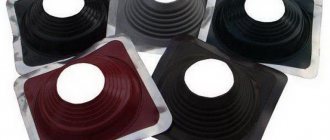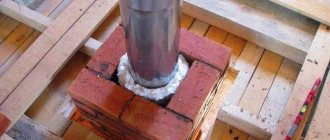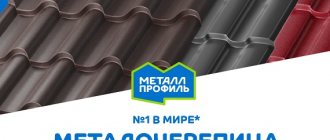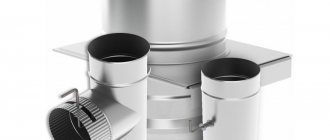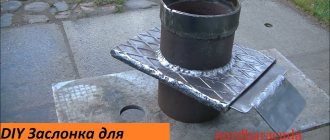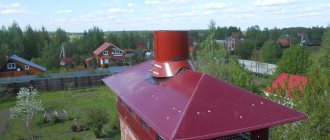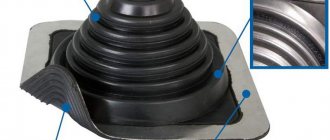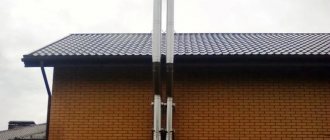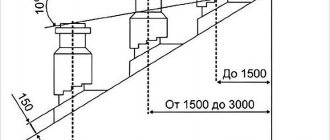Every developer wants to get a warm house that will be heated with minimal investment. The widespread use of modern technologies and the construction of lightweight houses have led to the fact that not every foundation is able to withstand the load that a massive brick oven will produce. They have been replaced by lightweight structures that can provide heat even to houses with an area of over 200 square meters. In this case, to remove combustion products, the construction of a heavy chimney is not required, but you can limit yourself to a light-weight system, the elements of which are reliably connected to each other. Let's figure out how to properly install a sandwich chimney with your own hands in order to produce a high-quality installation and avoid unnecessary installation costs.
Sandwich chimney with external installation Source torgpoliprom.ru
Design Features
The reliability of the design of lightweight systems is ensured through the use of several layers of modern building materials. The design is called “Chimney Sandwich” in honor of the English sandwich, in which several ingredients are combined in layers. It consists of two pipes made of high-quality steel alloy.
The diameter of the outer pipe is significantly larger than the diameter of the inner one. A layer of thermal insulation material is laid between them, usually non-flammable stone wool. The outer pipe provides protection against damage and mechanical stress. The inner tube can withstand high temperatures. A cushioning layer of mineral wool compensates for the difference in temperature conditions. The thickness of the thermal insulation layer depends on:
- differences in diameters of the inner and outer pipes;
- temperatures during operation;
- the diameter of the stove opening to which the chimney is connected.
Important! Stone wool is a non-flammable material. Therefore, in the event of deformation of the internal steel contour, it will be able to protect against combustion products from entering the chimney.
Sandwich chimney pipes Source i1.wp.com
The principle of assembling a chimney is identical to that of a constructor. You can invite a specialist, but after learning how to make a sandwich pipe for a chimney with your own hands, you can carry out a complex of work yourself. The system consists of parts that are equipped with fasteners for a strong connection with each other. The elements have two types of connections that allow installation using:
- corrugated end elements, which allow easy assembly, but require the use of expensive sealant;
- socket connection, complex due to the need for careful adjustment of parts, but more airtight if installed correctly.
A properly installed sandwich chimney will last 15 years or more. But you need to remember that to prevent soot outbreaks, the system must be cleaned regularly.
Assembling a sandwich chimney with your own hands Source klimatlab.com
Pros and cons of stainless chimneys
The chimney design for a gas boiler differs little from a conventional one, but nevertheless the difference in quality is noticeable.
pros
- Safety. Stainless steel heats up faster than regular steel due to its high chromium content. This leads to the fact that the draft is not retained in the cold channels of the pipe.
- Long service life. A stainless steel pipe is not as prone to cracks and crumbling, which is typical for brick and concrete chimneys.
- Good maneuverability. Similarly, bricks cannot be laid without corners where exhaust is trapped. Stainless steel comes without corners, so the cross-country ability is much higher.
- Light weight. Particular advantage for wooden and old houses.
- High heat resistance. Compared to brick, the frost resistance and cooling/heating cycle of stainless steel are many times greater. The pipe for a gas boiler is easy to repair, because... any section can be independently dismantled and replaced.
In general, stainless steel chimneys meet all requirements for chimneys.
Minuses
There is only one – the requirement for insulation. The stainless steel chimney pipe for a gas boiler heats up quickly, but unevenly. This can lead to both malfunction of the heater and damage to the outlet itself.
Advantages and disadvantages
Technological progress has made it possible to move away from the use of heavy foundations when building a house and to build on prefabricated pile-screw and drill-fill foundations. And if previously heating a house could only be done using a heavy Russian stove or fireplace made of brick, now they have been replaced by modular structures made from a portal with a firebox weighing about 500 kg.
Sandwich chimney in a bathhouse Source spskamin.ru
When wondering how to assemble a chimney for such systems, you need to know the advantages and you need to know their advantages and disadvantages:
- When used, only the internal part of the system becomes very hot. Thanks to the compensation layer of mineral wool, the outer pipe has an acceptable temperature, which significantly reduces the risk of burns;
- after heating the chimney, the draft increases significantly;
- the steel surface of the chimney is not susceptible to soot settling as in systems made of brick or ceramics;
- due to the rapid removal, combustion products do not accumulate in the chimney, which does not lead to the accumulation of condensate on the walls;
- the design of the chimney provides maximum protection: on the outside it is protected by the outer diameter of the pipe from deformation under direct influence, the inner pipe does not allow heat and combustion products to pass through, and mineral wool is a protective layer from fire since it is not hot;
Installed sandwich chimney Source petropech.ru
Since the sandwich chimney system is relatively light in weight, its installation does not require the installation of a special foundation. It is advisable to strengthen the structure of the subfloor with additional lags, but if this is not possible, this may not be done. With proper care, the system will last a long time, but after about ten years, areas with partial depressurization may appear in the seam area.
Rules of operation and maintenance
In order for the system to function properly during the heating season, it must be maintained regularly. The owner must clean the structure at least twice a year from soot and soot deposited on the walls.
You cannot burn garbage, as well as various household waste, in stoves and fireplaces, or use resinous coniferous wood for kindling.
To facilitate further maintenance, it is imperative to install a condensate collector and provide a reserve hatch , with the help of which condensate will be drained and the internal surface will be cleaned of soot. It is important to ensure free access to these areas when installing components of a domestic gas boiler.
Calculation of sandwich chimney pipe sizes
Diameter
To determine the optimal pipe diameter size for a sandwich chimney, you need to know the conditions under which the operation will take place. The heating power of the furnace depends on how large the area is, as well as what the planned temperature range is.
As a rule, in order to heat 10 square meters they take 1 kW. Accordingly, in order to heat an area of 100 square meters, you need to purchase a 10 kW stove. Having decided on the power, you can choose a model for individual parameters.
Chimney facing the street Source santehnika-otoplenie.ru
If a system is needed to remove combustion products from a heating boiler, then you need to know the type of fuel and the power of the boiler itself. The higher the temperature of the gases passing through the chimney, the stronger its heating will be. The lowest temperature is for gas boilers, which heat up from 120C to 200C, and the highest for coal boilers, where the temperature of combustion products reaches 700C.
The choice of sandwich should begin with the diameter of the inner pipe. The more powerful the stove is planned to be installed, the wider the diameter should be. For example, if a 3.5 kW oven is installed in a room of 4 square meters, then the width of the outlet from it will be 158 mm. And for an area of 90 square meters with a 9 kW oven, a hole of 220 mm is suitable.
Despite the fact that open fireboxes are not currently recommended for installation, they also have their own standards. The outlet channel in this case should be no more than one hundredth of the total volume of the boiler. If this rule is not observed, the draft in the system will be weak with potential turbulence of air masses with combustion products.
Sandwich chimney inside the house Source pechivrn.ru
Height
To ensure safe removal of smoke away from people, it is necessary to maintain height standards. The total length of the structure should not be less than 5 meters. If the condition is not met, reverse draft may occur, as a result of which the residential area will be subject to smoke. In addition to the overall length, you must also follow the rules for venting the chimney through the roof.
If the roof is pitched, then the upper edge of the chimney should be at least 0.5 meters above the ridge if the middle of the pipe is at a distance of 1.5 meters or less from it. At a distance from the chimney of 1.5 to 3 meters, the chimney should end at the same level as the ridge in a horizontal plane. When removed by more than 3 meters, the top edge should be 10 degrees below the ridge.
Rules for installing a sandwich chimney on the roof Source stroy-good.ru
If the sandwich system is installed on a flat roof, then the height of the upper edge should be located at a distance of 0.5 to 1.5 m. Since the total size of the chimney should not be less than 5 meters, if the dimensions are insufficient, you can increase the length of the outlet through the roof to 30 cm, making sure to use special reinforcement braces.
Finishing the chimney on the roof
Finishing work includes work on sealing the joints of the chimney and roof, equipment for protecting chimneys and ventilation ducts from moisture and thermal insulation work. The important point is to give a beautiful appearance to all structures on the roof.
Chimney lining is done when low-quality brick is used, when there is a risk of destruction under the influence of precipitation. If the draft level is insufficient and the installation height of the chimney meets the requirements stated above, a layer of thermal insulation made of non-combustible materials is laid behind the casing.
Materials and methods of sewing
Regardless of the finishing method, the manufacture of a supporting frame is required, onto which the insulation and sheathing material will be attached. For the chimney, the frame is made only of metal. A profile for attaching plasterboard sheets is perfect for this. The fasteners must also be metal.
The optimal material for cladding is galvanized sheet or corrugated sheet. This type of cladding is low cost and easy to install. The galvanization is fastened with self-tapping screws with silicone or rubber sealing washers placed under the cap.
The chimney can be finished with the same material from which the roof is made
Finishing is also done with natural or artificial stone. In this case, it is necessary to additionally secure the stone to the surface of the chimney using dowels.
Stone finishing perfectly decorates the chimney and gives it the appearance of a small medieval turret
The upper part of the chimneys is protected from moisture getting inside using caps. Since installing a cap tends to worsen traction, the height of the cap should not be less than 150 millimeters. What the cap will be made of depends only on the personal preferences and financial capabilities of the owner of the chimney - it can be made from ordinary galvanized steel or a beautiful forged structure with a weather vane can be used.
Work on lining chimneys must be carried out in accordance with the requirements of fire safety regulations. Combustion products that are discharged from fireplaces, stoves and solid fuel boilers have a high temperature. In gas fuel boilers, the temperature at the outlet of the pipe is much lower, so they can be considered safe. But still, for all types of stoves and boilers, the chimney must provide good draft. The main requirement is to use only materials that do not support combustion.
In the case where the chimney and ventilation ducts are located in the same box, the chimney cut should be located significantly higher than the ventilation cut.
For proper operation of the chimney, it is necessary to clean it from soot, inspect it and eliminate defects at intervals of 2 times a year. The boiler must be operated strictly in accordance with the rules and not used for other purposes.
How to choose
Since different boilers produce different combustion temperatures, in each case the composition of the steel from which the inner and outer pipes are made can play a role. After burning, sulfur, sulfuric and hydrochloric acid may remain on the walls of the chimney. Temperatures also differ depending on the type of fuel used.
Sandwich chimney details Source www.stroimdom.com.ua
When learning how to properly assemble a chimney from sandwich pipes for a home or bathhouse, you need to know that different grades of steel react differently to aggressive influences. The most common:
- AISI 304. High temperature resistant steel alloy. It has a high content of nickel and chromium. It is used at elevated temperatures up to 1000C, since at low temperatures around 600C it becomes brittle;
- AISI 316. High alloy molybdenum stabilized alloy that is acid resistant. Characterized by the absence of corrosion;
- AISI 321. High alloy steel alloy stabilized with titanium. Suitable for use in the average temperature range, up to 800C. Corrodes when interacting with sulfur;
- AISI 430 . It is used at low temperatures, as it has a low level of resistance to aggressive influences. May be corroded. It is used in the use of inexpensive budget models.
Sandwich chimney components Source www.rus-dimohod.ru
Since it is most often impossible to determine the type and grade of steel with the naked eye, a magnet can be used to determine the type. When learning how to properly assemble a chimney from sandwich pipes for a stove or boiler, it is necessary to take into account the characteristics of steel. If the steel is of high quality, then it will not be attracted, but if the alloy is of low quality, then attraction will arise.
Subtleties of designing a smoke channel
When designing a chimney, everything matters: its size, configuration, cross-section, slope, and other parameters. When installing a smoke exhaust from a gas boiler, it is necessary to strictly adhere to the requirements of regulatory documents: SNiP 2.04.05-91 and DBN V.2.5-20-2001.
Rule #1 - compliance with channel cross-section standards
The cross-section of the chimney duct must be no smaller in area than the cross-section of the gas boiler pipe through which the device is connected to the chimney.
When constructing and connecting chimneys for gas boilers along their entire length, narrowing of the channel, curvature and the use of modules that are not suitable for the cross-section are unacceptable.
When simultaneously connecting two devices to the chimney, the cross-section should be increased, taking into account the likelihood of simultaneous operation of two devices. Those. the cross-section of the channel must be equal to the total dimensions of the pipes of both units of equipment.
Rule #2 - ensuring condensation control
Modern gas boilers are designed in such a way that the maximum amount of heat is supplied to the heat exchanger. Such a high efficiency contributes to the production of combustion products with a relatively low temperature.
As a result, moisture forms on the walls of the chimney. An increased amount of condensate, including aggressive substances, can have a destructive effect on the integrity of the walls of chimneys.
To connect a gas boiler to the chimney structure, use a special tee on which a device for collecting condensate is mounted
At the bottom of the chimney, there must be a condensate collector in the form of a removable container made of plastic or stainless steel. A glass made of galvanized steel is also not prohibited from use, but it will have to be changed frequently.
To protect the structure, it is recommended not only to lay the chimney out of brick, but also to line it, i.e. insert a special stainless steel pipe inside. Such pipes are durable and well resistant to corrosion.
An alternative solution to combat condensate can be lining, i.e. installation of a special flexible chimney. A special container is used to collect condensate. It is installed just below the place where the boiler pipe connects to the chimney.
Rule #3 - choosing the cross-sectional shape of the structure
The traditional cylindrical shape of the chimney is considered optimal for efficient removal of combustion products. In addition, it is easier to carry out preventive cleaning in such a chimney.
Chimneys with a cross-section in the form of an oval are considered quite acceptable, although not so convenient. Square designs also have a right to exist, but their traction indicators are usually reduced.
Rule #4 - performing slopes, turns, ledges
A vertical chimney without ledges is considered optimal for a floor-standing gas boiler. In practice, it is not always possible to achieve such a design arrangement.
Deviation from the vertical is allowed no more than 30 degrees. In this case, you should make sure that the cross-sectional dimensions of the inclined section comply with regulatory requirements.
In this case, the pipe itself connecting the chimney and the boiler must include a strictly vertical section with a height of half a meter or more. Of course, if necessary, some sections of the chimney can be made horizontal, but there should not be too many of them.
When installing a chimney structure for a gas boiler, the presence of inclined sections is allowed, the slope must be 60° or more degrees relative to the horizon, the length of the inclined section is up to 1 m
For example, if the height of the room in which the chimney is installed is about three meters, then the total length of the horizontal sections of the chimney should not exceed these dimensions.
Although, as mentioned earlier, the closer the chimney design is to the vertical, the better. It is not allowed that the slope of the chimney towards the boiler be more than 0.1 degrees. As for the turns of the chimney structure, their maximum number is three turns, no more.
Rule #5 - correct pipe connection
To connect individual parts of the chimney structure, special clamps are used. The slope of the chimney structure can be 15-90 degrees. A certain distance must be maintained between the connecting pipes and other surfaces.
It depends on what materials these surfaces are covered with. In places where flammable or even difficult-to-burn materials are used, it is recommended to maintain a distance of at least 25 cm.
The distance from surfaces coated with fire-resistant materials must be at least 5-10 cm. To protect the chimney from flammable materials, use asbestos cardboard, brickwork, etc.
When installing a chimney for a gas boiler, all its elements must be securely fastened, maintaining the correct spacing between fasteners
Particular attention should be paid to the junctions of individual sections of the chimney structure. They must be made of durable materials that do not bend under external influence.
All chimney fastening elements must have the same characteristics. Horizontal or inclined sections of the chimney should not be under load.
The chimney elements are inserted into each other to a depth that is equal to half the diameter of the pipe or exceeds this figure. No gaps in these places are allowed; the connection must be tight and airtight.
If the tightness of the connection of individual chimney elements is broken, carbon monoxide can enter the room unnoticed. Therefore, the condition of the chimney should be periodically checked, and good ventilation should be organized in all rooms where chimney pipes are laid.
Rule #6 - subtleties of pipe placement on the roof
Chimney pipes should rise above the roof ridge by 50 cm or more, while the distance from the edge of the parapet to the chimney pipe should be no more than 150 cm. If the axis of the chimney pipe is located at a distance of 1-1.5 m from the roof ridge, then it should rise above the ridge level by 50 cm or more.
This diagram clearly demonstrates how, in accordance with technical standards, the height of the chimney pipe relative to the roof ridge is determined so that it does not interfere with the formation of draft
If the work is located even further from the ridge, then it can be made the same height as the ridge. The pipe can be even lower if it is separated from the ridge of the roof by a distance of more than three meters.
In this case, you need to draw a conditional line down from the ridge at an angle of 10 degrees to the horizon. The height of the chimney pipe must reach this mark. It turns out that the further the pipe is located from the ridge, the smaller its height should be relative to the roof ridge.
There is no chimney on a flat roof, so here, in accordance with the standards, a chimney pipe with a height of 100 cm is erected. On a combined roof, the height of the chimney pipe should be about two meters.
The section of the chimney located above the roof and within the unheated attic must be insulated to improve draft and prevent condensation. One of the options for such insulation is basalt shell
The outer part of the chimney must be insulated. If you neglect this point, condensation will accumulate on its surface. Moisture can penetrate inside the chimney, which will lead to the development of corrosion processes and damage to the structure.
The part of the chimney structure that is located on the outside of the house also needs insulation. Insufficient insulation can also reduce the efficiency of the chimney and reduce its draft.
If it is not possible to remove the chimney through the upper floor and roof, coaxial chimneys are used. This option can be removed through the wall, while the intensity of removal of combustion products of blue fuel is not reduced at all.
Rule #7 - compliance with fire safety standards
At the chimney installation stage, it is necessary to take into account fire safety requirements. When the channel passes through walls made of different materials, they differ:
- if the wall is made of wood, insulation from a fire-resistant material is needed around it, and the pipe itself should be wrapped in asbestos;
- In a brick or concrete wall, foam insulation is sufficient.
The design of the chimney must comply with the requirements set out in the instructions attached to the boiler.
The chimneys of boilers that convert gas into thermal energy are predominantly of the mounted type. According to the push-on design, the channel is installed directly on the floor slab of the heating unit. However, it is permissible to connect to wall chimneys using pipes no longer than 40 cm.
If connected to a wall chimney, a gap of 14 cm must remain between the lower line of the pipe and the flammable ceiling. Between the upper line of the pipe and the flammable ceiling, a gap of 50 cm must be left if there is no fire protection, 40 cm if there is protection.
The passage of the chimney through a combustible structure is equipped with non-combustible heat-insulating materials or devices such as sandboxes
The area where the flammable floor intersects is equipped with a box of sand or a seal made of non-flammable insulation.
Type of chimney placement
If you are interested in how to assemble a chimney from sandwich pipes, you need to carefully analyze the place where you plan to install it. Depending on the area of the room, the location of the furniture, the level of humidity and other factors, it is necessary to choose the type of placement of the sandwich chimney. Installation is possible indoors or outdoors.
Outdoor installation
A chimney that is assembled from the street side significantly saves space inside the house or bathhouse. Having studied how to install a chimney in a bathhouse from sandwich pipes, you can assemble such a structure with your own hands. There is no need to make a decorative box for it, which significantly saves money.
Main types of chimney assembly Source otopleniehouse.ru
The system consists of assembled elements of the required length, which are connected to a structure located indoors with a special through pipe. To ensure good traction, it is necessary to follow the rules when the length of the passage section should not be more than 100 cm.
During installation, a technological slope of 3 degrees must be observed so that condensate does not accumulate in the boiler or furnace. In this placement, the roof must be more than 50 cm from the edge of the steel outer pipe. The best answer to the question of how to properly install a sandwich pipe in a bathhouse, outside or inside, would be installation from the street side.
Important! If continuous use is not planned in winter, it is advisable to insulate the chimney to avoid freezing and deformation from temperature changes.
External installation of a sandwich chimney Source fluesystems.ru
See also: Catalog of companies that specialize in the installation of stoves, fireplaces, grills and barbecues.
Indoor installation
The chimney, which is installed in the room, consists of an internal part of the system, located perpendicular to the floor, and an external part, discharged through the roof. The structural parts must be joined together in open areas so that inspection can be carried out. A joint located in the interfloor ceiling does not provide such an opportunity and is considered a potential fire hazard, since if the seal is broken, the wooden floors, floor materials of the second floor and ceiling of the first will overheat.
The placement in a completely vertical position gives a good level of draft, and in addition, such a chimney is easy to maintain. If during installation it turns out that when installed vertically, the chimney rests on the ceiling or rafter, then in order not to interfere with the structural part of the house, it is better to bend the pipe using special connecting elbows.
How does a chimney work and why is it needed?
Chimneys are divided into the following types:
- external or internal;
- with one or two circuits;
- made of brick, ceramics or steel.
And it doesn’t matter what type of chimney you use for your needs - it is important to know and be sure to follow certain rules. Many people who have no experience in construction think that a chimney is just a channel installed in a special way. And all other parts of unknown purpose are not needed. But this is far from true. All you have to do is remove something “unnecessary” from the chimney, and it will immediately stop working. This means that in order to study the rules for making chimneys, it is first necessary to study its design.
The chimney only looks like a straight channel for removing smoke; in fact, its design is much more complicated
The ideal chimney design is a vertical channel. But practice shows that a chimney can have several bends along its length. Therefore, to pass through walls, ceilings and roofs, elements such as pipes, elbows and tees are used.
What is a chimney elbow?
When passing through the ceiling, the chimney duct may rest against the beam. To go around it, use a knee curved at a certain angle. In the case where part of the channel has a horizontal section, it is also mounted on an elbow or tee. Using an elbow makes it difficult to clean the chimney in the future, but in a tee this possibility is ensured by a design that includes a special removable element. A mandatory requirement is that the connection of the elements should not allow combustion products to leak out.
The elbow allows you to go around beams and other obstacles in the path of the chimney
To ensure safe passage through the ceiling in a bathhouse or house, pass-through pipes are used.
This is done as follows:
- a hole is cut in the ceiling;
- the pipe is installed and insulated;
The feedthrough pipe is used to prevent direct contact of the heated pipe with coatings made of flammable materials. - a pipe comes out through the pipe.
For the roof it is done in exactly the same way, but a corner pipe is used.
How to choose the right chimney design
Determining the required type of chimney depends only on the type of heating stoves used. This takes into account factors such as:
- temperature of combustion products;
- pressure value inside the chimney;
- degree of moisture condensation;
- intensity of release of aggressive chemicals;
- resistance to soot combustion;
- dimensions and many other parameters.
A brick chimney is a clear and affordable solution, but its use is justified only when using solid fuel boilers. Brick is a fire-resistant material and can easily withstand not only the high temperature of combustion products, but also the combustion of soot. But for gas, liquid fuel, as well as gas generator boilers, a brick chimney is absolutely unsuitable. The combustion products in them have a very low temperature, which promotes moisture condensation and, as a result, leads to rapid destruction of the chimney. But a brick pipe can be upgraded for use in conjunction with a boiler running on natural gas when replacing a solid fuel boiler by installing a steel box inside the channel. The costs of such modernization will be minimal.
A brick chimney can only be used for solid fuel stoves and boilers
The ideal choice for boilers operating on gaseous or liquid fuel and for gas generator boilers is a ceramic chimney. This chimney is very durable, resistant to corrosion and has a long service life. However, its installation requires full compliance with the manufacturer’s instructions.
Chimneys made of brick and ceramics have significant weight, so they are installed on a separate foundation
Chimneys made of brick and ceramics have a large mass, which additionally loads the foundation of the building. For them, the foundation is very often cast separately. And in order to correctly build such a chimney, special calculations are required.
In the case where a separate chimney shaft is not provided inside the building, the best choice would be to install a steel pipe. It has a shorter service life compared to ceramic, but it fully performs its task. The advantages of a steel chimney are:
- low weight;
- moderate cost;
- easy assembly.
If several boilers operating on different types of fuel are installed in the house, then it is necessary to choose a chimney designed for more difficult operating conditions. For example, a steel chimney installed on a solid fuel boiler will burn out very quickly under the influence of high-temperature gases.
Requirements for modern chimneys
High-quality removal of combustion products means, first of all, safety and comfort. An effective chimney must withstand high temperatures, be moisture and corrosion resistant, and provide good draft. The best form of chimney is a cylinder, the walls of which have a smooth surface, which prevents soot from settling and increases the time between channel cleanings.
Modern chimneys not only perform the function of removing fuel combustion products, but are also decorative elements that decorate the roof.
Construction standards define the basic requirements for the design of a chimney:
- the cross-sectional area of the chimney should not be less than the cross-sectional area of the boiler outlet channel;
- for the production of metal chimneys, corrosion-resistant steel with a thickness of more than 0.5 mm must be used;
- in the lower part of the chimney it is necessary to provide a pocket 250 mm deep to ensure the collection and removal of soot;
- the direction of movement of the chimney channel should not change more than 3 times;
- the bending radius of the channel cannot exceed the diameter of the chimney;
- the total length of the chimney must be more than 5 m.
If the chimney meets all these requirements, then its operation will be effective.
Video: chimney device
Sandwich pipe connection options
If you are interested in the question of how to assemble a sandwich chimney, another question will probably arise: how to join the system pipes together. There are two possible options, and each of them has its own name:
- “By smoke”, when the lower pipe goes inside the upper one. In this case, combustion products have no way out and are freely discharged upward;
- “Ppo condensate”, when the inner upper pipe is inserted into the lower one. External pipes are assembled with the top side facing out.
It is believed that in the second case the risk of moisture getting into the insulation is reduced, but if the tightness is broken, then some of the combustion products may enter the room.
Connection for smoke and condensate Source www.rusovent.rf
Attachment option
This type of connection of the chimney to the OP is conventionally called an economical option, since the installation of the entire system requires less fasteners when compared with other types of connections. Here the pipe stands and rests directly on the heating device. The connection is simple, but has serious drawbacks. In the mounted version, flue gases are removed by direct flow from the furnace. Because of this, excessive draft is created, which makes the fuel combustion process uneven and also increases its consumption.
Top-mounted chimney connection option
The next problem with a top-mount connection is condensate drainage. During the operation of heating devices, condensate forms, which must be removed from the firebox. Otherwise, condensation or moisture from atmospheric precipitation will fall directly into the firebox, which will lead to a reduction in its service life or destruction. And while a windproof umbrella will protect you from precipitation, there is practically no protection from moisture condensing in the channel.
Another disadvantage of a push-on connection is that it makes cleaning the chimney system more difficult. In this case, to clean the chimney, you need to dismantle the lower elements and securely fasten the upper part of the pipe. Another option is to remove soot from the firebox, if, of course, such a function is provided in the heating device. All this leads to an increase in the cost of cleaning and maintaining the diesel engine.
Sandwich system kit details
Once the location of the chimney has been chosen, whether outdoors or indoors, you need to understand what parts will be needed to understand how to properly assemble the chimney. To compile a list of the necessary parts, you can independently contact a specialized store or request a commercial offer via the Internet. But it’s better if you have an independent understanding of the process and what parts will be useful during assembly.
Manufacturers produce chimneys with all the necessary components so that a full assembly cycle can be carried out. If there are differences between manufacturers' models, they relate to decorative or connecting functions. The list of elements is usually the same. Therefore, having decided on the names, you can choose a manufacturer based on the criteria of reliability or availability.
Sandwich chimney parts Source pech-kamin.ru
Maintenance of the assembled system
During operation, soot growths may appear on the walls of the sandwich chimney, reducing its cross-sectional area, which can lead to smoke in the room and a fire. Therefore, it is necessary to clean the duct at least twice during the heating season. It is convenient to carry out cleaning through the inspection hatch in the plug; if there is none, you can open the plug completely for these purposes by unfastening the clamp.
The condensate collector also requires regular inspection to ensure timely discharge of accumulated liquid. If the condensate drain is connected to the sewer system, then the condition of the connecting tube must also be examined: clean it if it is clogged and replace it if it fails. To clear a clogged drip line, you can use a thin, strong wire.
Required Tools
After carrying out all the necessary calculations and deciding how to make a chimney pipe yourself, you need to prepare all the required elements. In addition to the list of parts of the sandwich system itself, you need to have on hand a list of the following items:
- clamps for tightening;
- support brackets;
- necessary hardware fasteners;
- heat-resistant sealant;
- grinder, metal scissors;
- spatula for sealant;
- roulette;
- square;
- screwdriver;
- drill and hammer;
- building level.
You also need a marker or construction pencil for marking. When assembling, the joints of the parts must be secured with clamps. The entire resulting structure is fixed vertically along the wall using brackets in increments of 1.5 to 2 meters.
Elements of modular systems
To draw up an installation diagram, purchase components and subsequent assembly, you need to understand what parts are used in a double-circuit chimney. We list the main elements, accompanied by photographs:
- straight sections of sandwich pipes 25, 50, 100 cm long;
- tees at 45, 90°;
- elbows 90, 45, 30 and 15 degrees;
- transitions from a single-wall pipe to a double-wall pipe - “start sandwich”;
- rotary gates (flaps);
- condensate collectors and various heads;
- ceiling passage units (abbreviated PPU);
- support platforms, brackets;
- fastenings – crimp clamps for guy wires;
- pitched roof sealing elements called master flash or “kryza”;
- end caps, skirts.
Note. Here is a partial list of chimney parts. There are direct channels with inspection and condensate drainage, floor stands, inspection hatches, and crosspieces.
Double-layer pipes are connected to other fragments using the socket-profile joining method. In a more accessible language, the connection is called “tenon-groove” or “male-male”, as you like. When manufacturing each shaped part (except for the end parts), a tenon is provided on one side and a groove on the other.
Scheme of installing a chimney along the outer wall of a country house
As an example, we suggest considering the assembly diagram of a wall-mounted sandwich chimney starting from the boiler:
- We connect a single-wall pipe to the output of the heat generator through a coupling, then mount the starting adapter onto the sandwich.
- We connect to the transition a straight section of a double-circuit pipe facing the street. There it is inserted into the tee.
- Below the tee we place an inspection section, then a support platform and a condensate collector. The structure is placed on a wall bracket.
- We rise from the tee in straight sections, fasten it to the wall every 2 meters with sliding brackets, and compress the joints of the elements with clamps.
- At the end of the chimney we install a cone without an umbrella (for a gas boiler), a simple cap or a deflector.
Comment. If a horizontal chimney duct crosses a wooden wall, you need to cut a square opening and install the PPU in accordance with fire safety requirements.
When you need to get around the roof overhang, we use 2 bends at 30 or 45 degrees. We secure the end of the chimney with guy ropes so that it does not sway in the wind, as was done above in the photo. Watch the video for professional installation of a sandwich pipe for a steel furnace:
Chimney assembly
If you decide to implement the question of how to make a sandwich chimney correctly with your own hands, you need to once again make sure of the quality of the system and check the availability of the passport before starting the installation. This document must be handed over upon purchase and it indicates a possible assembly diagram, as well as some technical parameters of the composition of the chimney.
When the heating device is already installed, you need to insulate the wall with calcium silicate or mineralite. This must be done immediately, since after installing the chimney there will be no access to the wall. Also, you immediately need to mark and drill holes for the bracket for connecting the mono-pipe and pipe.
Elements of a sandwich chimney assembly Source pandia.ru
When starting assembly work, you need to coat the parts of the outlet of the heating device with sealant. After this, a tee is connected to the boiler or furnace pipe, which contains a plug and a device for collecting condensate.
On the opposite side, a mono pipe is connected to the tee. After the tee is firmly seated on the pipe, it is pushed in all the way and tightened tightly with a clamp. After screeding, you need to apply a building level and if everything is normal, then you can secure the first element with a support bracket to the wall.
Next, the pipes are connected to each other in the chosen way: “through smoke” or “through condensate.” All joints between parts are fixed with heat-resistant sealant. To apply it you need to use a spatula. After application, the composition is distributed in an even layer over the entire surface of the edge of the element.
Support bracket Source topijar.ru
The sequence and list of necessary parts depends on how the chimney will be located. When the installation is carried out indoors and in a vertical position, it is advisable to install a tank for heating water or a specialized mesh heater.
If you place the sandwich elements at once, then exposure to high temperatures may cause the thermal insulating mineral wool layer to sinter, which will cease to perform its functions. The steel can subsequently burn out quickly.
If the question arises of how to assemble a chimney from sandwich pipes into a bathhouse and the system must be taken outside, then first a pipe is installed, and after it a section is immediately placed in a horizontal plane. The passage section must not be installed in a completely horizontal position or with a slope towards the premises, as accumulating condensate can get inside the heating device, which can lead to its deformation.
Chimney indoors Source dizajninterer.ru
Installation recommendations
To carry out the work, you will have to purchase pipes whose length is 1 meter. The chimney in a house is made up of main parts. You will also need a tee for pipe inspection. It is important to buy a tee for collecting condensate, which is used to clean joints. If the pipe has turns equal to 45 degrees, then you will need corners that are made of the same material. Make sure you have a compensator; it takes on the load from the expansion of the chimney elements during cooling and heating. The system must be installed on the roof; for this, an adjoining unit is useful. In order to prevent the entry of rain, leaves, snow and dust, the system should be equipped with a cap.
Roof passage
When learning how to properly assemble a chimney from sandwich pipes for a bathhouse or home, special attention should be paid to the place where the sandwich chimney passes through the roof. It is extremely undesirable to crash into the rafter structure as this can negatively affect the roof structure as a whole. The holes should be:
- with a pitched roof of oval or round shape;
- on flat roofs or sheathing with frequent square or rectangular pitches.
The opening is cut with a jigsaw after applying the appropriate markings. The distance from the wooden roof elements should be 13 cm or more. If the chimney gets into the rafter, then you need to use your knees to take it to the right place.
Passage through the roof Source stroy-podskazka.ru
After the chimney is brought outside, there will be a gap between the roofing material and the sandwich pipe, which must be securely and hermetically closed. For this, the best option would be to use a master flush. Its design includes a flanged base reinforced with aluminum for a complete seal and a silicone cone-shaped cuff located at the top.
After installation, the master flush will reliably protect the roof and under-roof space from precipitation and dust. For maximum tightness, before installation, you need to trim the top part so that it is 20% smaller than the chimney pipe.
After this, the master flash is put on the pipe, lowered down to the roof and fixed with silicone glue. Then the upper edge is tightened with a clamp, and the lower edge is treated with sealant. To complete the installation, a head is placed on the upper edge of the pipe and secured with self-tapping screws.
Wall and floor options
These types of connections are similar, except that the weight of the chimney is supported not by the heating device itself, but by fastening elements (console) located on the wall - this is a wall-mounted option. In the floor-standing version, the chimney stands on the floor.
Wall and floor-mounted chimney connection options
This connection option has significant advantages and also simplifies the operation of the chimney system and heating device:
Advantages of wall connection
The principle of operation of the chimney
As with any heating system, a chimney for a gas boiler is needed to release combustion products into the atmosphere and supply fresh air for complete combustion of the fuel. How it works: in accordance with the law of physics, according to which light warm air tends upward, cold air settles below. Draft in the chimney appears due to the temperature difference: hot gases in the pipe and cold air outside.
If the chimney is installed correctly, it is not only safe, it improves the quality of the boiler’s operation and increases its efficiency, making the microclimate in the house more comfortable.
The chimney for a gas boiler is a complex structure, which includes:
- Smoke exhaust pipe;
- An adapter that connects the pipe and the boiler pipe;
- Branch pipe for passing the chimney through the wall, ceiling, roof;
- Fastening elements;
- Condensate collector;
- A tee with a fitting is necessary for draining condensate;
- Bends.
This is the basic configuration, there may be different variations.
Room standards for installing a gas boiler, where it is better to install the device
The premises where the gas unit is planned to be installed are subject to the most stringent requirements.
According to current standards, it is allowed to install them in non-residential premises equipped with high-quality ventilation.
In addition to the presence of ventilation, the area of the room must correspond to the power of the unit and the design of the combustion chamber. When a boiler and a gas water heater are installed together, their capacities are summed up.
Important! According to existing standards, the installation of two gas devices is allowed in one room. The following standards have been established:
The following standards have been established:
- gas boilers with a power of less than 30 kW are allowed to be installed in rooms with a volume of at least 7.5 m³;
- boilers with a power of 30-60 kW require a space of more than 13.5 m³;
- for installation of more efficient boiler equipment, the minimum volume is 15 m³.
Standards for installing the device in the kitchen of wooden and other types of houses
It is important for homeowners planning to place equipment in the kitchen to know that there are special standards for this room:
- The area is more than 15 m².
- The height of the walls is at least 2.2 m.
- A window opening outward, equipped with a window. For 1 m³ of room volume there should be 0.03 m² of window area.
Photo 1. Gas boiler located in the kitchen. The device is installed in a special cabinet, which is closed with a lattice door.
- If the building is wooden, then the wall adjacent to the boiler is covered with a fire-resistant shield. The size of the shield is determined so that it protrudes 10 cm beyond the boiler at the bottom and sides, and covers 80 cm of the wall at the top.
- When choosing a floor-standing model, a base made of fire-resistant material (brick, ceramic tile) is installed under it, protruding 10 cm on all sides of the boiler.
- In addition to the presence of exhaust ventilation, there is a gap at the bottom of the door for fresh air to enter. It ensures constant air circulation.
- When installing a heating unit, it is necessary to maintain a certain distance between the wall and the boiler (more than 10 cm).
Requirements for a separate boiler room
When constructing an extension to the main building to accommodate boiler equipment, the following conditions must be met:
- the foundation of the extension is carried out separately from the main building;
- the design is made of fire-resistant materials, the same requirements are imposed on the interior decoration;
- mortar is mixed on sand;
- the foundation for installing the boiler is poured separately, after the completion of the extension;
- the base intended for installation of equipment is 15-20 cm higher than the floor surface.
Further requirements correspond to the conditions for installing boilers in non-residential premises:
- ventilation system providing three air changes within an hour;
- the distance between the floor and ceiling is at least 2.5 meters;
- boiler room volume is more than 15 m³, a larger volume ensures comfortable maintenance of all equipment elements;
- Water must be installed and a drain must be installed in the floor;
- all electrical outlets in the room are grounded;
- daylight;
- When placing the boiler installation, free access to the unit is ensured.
Photo 2. Boiler room with two gas boilers. The devices are installed on a special pedestal, providing access to sunlight.
Certain requirements are also imposed on the equipment used when operating the boiler:
- only metal pipelines are used for gas;
- The device is grounded using a separate grounding circuit;
- Without a gas meter, an automatic valve that shuts off the gas supply in the event of a leak, and a gas analyzer, the equipment cannot be put into operation.
Reference. Modern gas units are equipped with protective automatic systems of varying complexity that shut off the gas supply in the event of a malfunction.
Types of chimney pipes
Chimneys can be made of metal, brick, asbestos cement and sandwich pipes.
Depending on the location of installation, chimneys can be classified into:
- wall In this case, the pipe is located in the main wall of the house, regardless of whether it is internal or external;
- mounted - the pipe is mounted directly on the stove and is brought out strictly vertically;
- suspended - the chimney is fixed externally to the wall using brackets or other fasteners;
- indigenous. In this case, the chimney is a free-standing structure.
